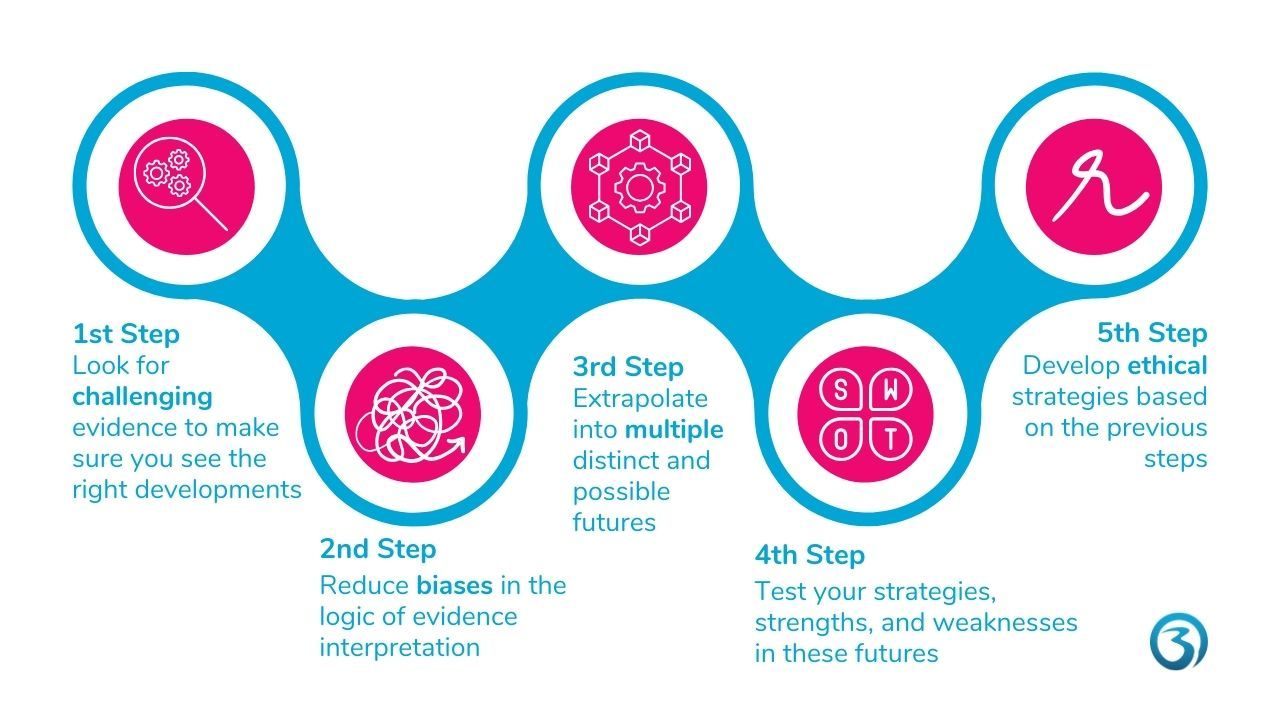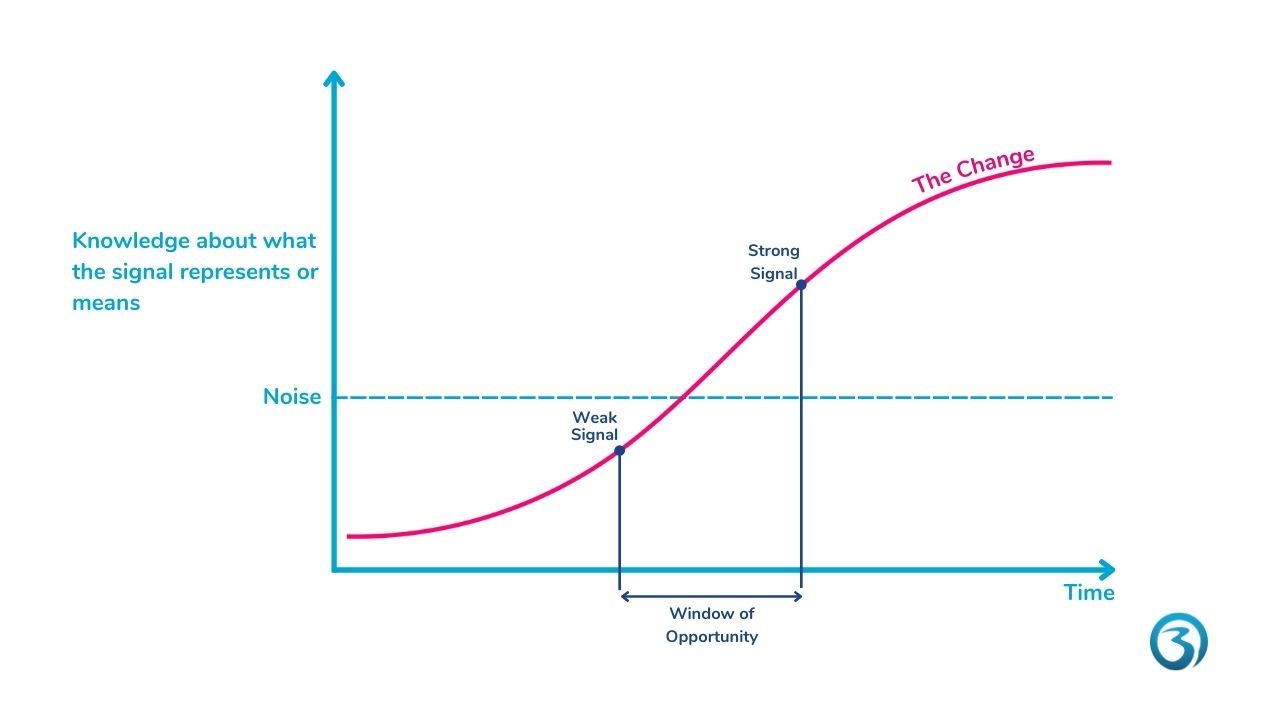Methodology
Understanding Tomorrow's Terrain
Your Roadmap to Informed Decision-Making in an Uncertain World
The problem with predicting the future is that you can't know you're right until after the fact. And then you're too late.
The only thing we can hold onto is the futuring proces. We have an excellent chance to make better decisions when that is robust, evidence-driven, and debiased.
The process should return a map of contextual changes over time that guides our choices, illuminates potential pitfalls, and helps turn educated guesses into actionable strategies.

Uncertainty Embraced: the Methodology of Navigating Uncharted Waters
Let’s face it; uncertainty can be a real pain in the you-know-what. But what if I told you that uncertainty could be your secret weapon for gaining an edge in market competition?
The first organization that effectively embraces and acts upon uncertainties emerges as the winner. It has the advantage of developing and testing new processes, services, products, marketing campaigns, investments, and strategies ahead of the competition. Introducing a finished product before anyone else establishes a firm position to build on.
Making sense of uncertainty is like interpreting a treasure map and being the first to discover the hidden loot!
You reduce uncertainty by verifying the facts, then navigate the unpredictable with adaptive strategies, ready to pivot based on external shifts.
-
First, you look for challenging evidence to make sure you see the right developments (read more)
-
Second, you reduce biases in the logic used to interpret the evidence.
-
Third, you extrapolate the evidence into multiple, distinct future scenarios.
-
Fourth, you test your organization's strengths, weaknesses, and strategies in every scenario.
-
Finally, you ideate ethical alternatives to find the best possible strategy considering the circumstances.

Step 1. The Power of Weak Signals
Look for challenging evidence to ensure you see the developments you mustn't miss.
The difference between the information executives usually include in decision-making, and mine is enormous. They rely on strong signals, and I rely on weak ones.
Strong Signals
Weak Signals
Weak signals are early warnings of emerging opportunities and threats.
When you watch for weak signals, you widen the window of opportunity. Because you see a change earlier than others, you gain the time to develop, test, and implement innovations that address the new normal.
However, weak signals cannot be found with your usual search methods. You need counterintuitive search methods and a curious mind.

Step 2. Cognitive Diversity and Collaborative Synthesis
Reduce biases in the logic of interpreting the evidence from step 1.
In the ever-evolving landscape of business, we find ourselves navigating a future that, truth be told, can never be fully predicted. While data, charts, and trends give us hints, they don't provide complete answers. We're making educated guesses, venturing into a terrain where certainty is elusive.
Our inherent bounded rationality—our human limitations in processing all available information—means we're naturally selective about what we internalize. This selectivity leads to blind spots: gaps in our understanding that might seem small but can have profound implications on our strategies and decisions.
But here's the silver lining: Your expertise, your unique perspective, can fill the gaps of another, and theirs can do the same for you. It's through these interwoven insights that we can create a fuller picture.
Imagine a team, diverse not just in background but in thought—a mosaic of minds. A setting where every member feels empowered to bring their distinct viewpoints to the table, unearthing insights that might otherwise remain hidden. By synthesizing the best of what each mind offers, we don't just create a shared vision; we craft a richer, more nuanced understanding of what's ahead.

Step 3. Possible Futures: Testbeds for Strategies and Decisions
Extrapolate step 2's multifaceted evidence into multiple, distinct future scenarios.
We can stress-test our strategies and decisions in varied scenarios by crafting multiple possible futures. By clustering the evidence (instead of choosing), we keep as much trend information within the scenario matrix as possible.
The trend clusters with the highest possible impact and uncertainty form the scenario axes.
Scenarios emerge from each matrix cell.
Step 4. Link Your Organization to the Possible Futures
Test your organization's strengths, weaknesses, and strategies in the scenarios you created in step 3.
We connect our organization to each scenario by examining our positioning, strengths, and weaknesses for that scenario. We then craft strategies for each scenario, depending on our relative position and strengths.
By envisioning diverse outcomes, we can ensure our plans are resilient, adaptable, and poised for success, no matter which path tomorrow takes.
Step 5. Navigating the Future with an Ethical Compass
Examine step 4's strategies for ethical effects that may emerge over time.
In strategy formulation, ethics isn't an afterthought—it's foundational. By grounding decisions in firm ethical principles and integrating diverse stakeholder perspectives, we ensure our strategies are both resilient and responsible.
As we navigate the unpredictable future, our ethical compass remains our unwavering guide, ensuring decisions that benefit us and the broader stakeholder context.

Your Guide to Harnessing Weak Signals for Success
As you delve into these practical Q&As, you'll discover actionable steps to implement weak signal analysis effectively within your organization (instead of theory.
How can I use weak signal analysis for strategic planning?
How can I use weak signal analysis to promote an open organizational culture and change?
How can weak signal analysis contribute to our risk management efforts?
How can weak signal analysis help drive innovation within our organization?
How can we use weak signal analysis to gain a competitive advantage in our industry?
How can we leverage weak signal analysis to identify new business opportunities?
What are some ethical considerations when conducting weak signal analysis?
What challenges and pitfalls should organizations be aware of in weak signal analysis?
Which organizations have been successfully due to weak signal analysis?
How can I organize continuous weak signal monitoring without it becoming a burden?
What are the essential tools and technologies for effective weak signal analysis?
What are some emerging trends in weak signal analysis?
Ready to harness the power of weak signals for your organization's success?
Start by identifying one decision or area where weak signal analysis can make a difference and use the tips here to include weak signals in your decision-making.
Go to Services if You Need Help
